L
Luke Wilkinson
Guest
Vauxhall has revealed the new all-new Astra, and for this eighth-generation version of the brand’s family hatch icon, things push more upmarket and more technological, as it goes after the Volkswagen Golf.
To that end, the Mk8 Vauxhall Astra is the first version of the hatchback to date that will be offered with plug-in hybrid power, and buyers will have their choice of two electrified powertrains.
Vauxhall has confirmed precious few details about the Astra’s engine range, although the brand has said that the most potent plug-in model will have an output of 222bhp. That suggests the new Astra will use the same 1.6-litre plug-in hybrid system found in the latest Peugeot 308 hatchback, with which it shares its platform - the PSA developed, Stellantis EMP2 architecture.
A maximum range of around 31 miles on battery power alone is expected, and charge times should be similar to the 308’s, taking around seven hours to top the batteries up to full. Both PHEV systems will also be mated to an eight-speed automatic gearbox as standard.
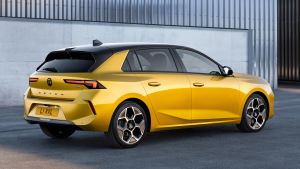
Vauxhall Astra - rear static
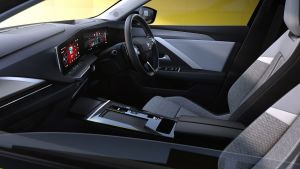
Vauxhall Astra - cabin

Vauxhall Astra - dash
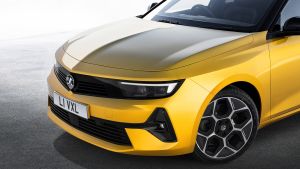
Vauxhall Astra - front detail
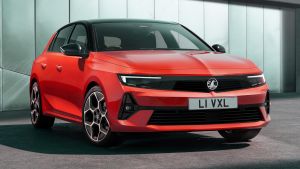
Vauxhall Astra - front red
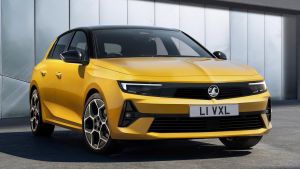
Vauxhall Astra - front static
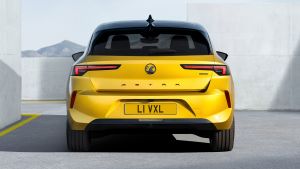
Vauxhall Astra - full rear
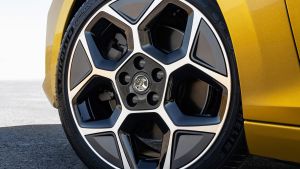
Vauxhall Astra - wheel

Vauxhall Astra - full front

Vauxhall Astra - side
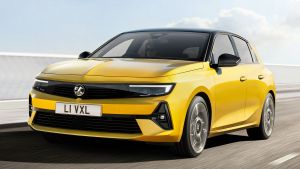
Vauxhall Astra - front

Vauxhall Astra - front 2

Vauxhall Astra - rear
The rest of the Astra’s engines will also be borrowed from the Peugeot 308. Buyers will be offered either a 1.2-litre petrol or 1.5-litre diesel unit with outputs ranging between 108bhp and 128bhp. The pure combustion engines will come with a six-speed manual gearbox as standard, but an eight-speed automatic will be available on the more powerful variants.
The eighth-generation Astra pulls plenty of design inspiration from the Mokka SUV, adopting Vauxhall’s new Vizor grille and headlamp arrangement. The latest iteration of the company’s Griffin logo appears on the car’s nose and tail, and there’s also the option to specify two-tone paint.
The Astra’s headlights are Vauxhall’s latest Intelli-Lux LED Pixel units. The lamps have 168 LED elements between them, and they can automatically adjust the beam pattern to light up challenging roads or avoid dazzling oncoming road users.
It measures 4,374mm long and 1,860mm wide – and the wheelbase has grown by 13mm over the previous model to 2,675mm, which should liberate a little extra space for rear-seat passengers. Boot space also stands at 422 litres, which is 41 litres more than you get in the Volkswagen Golf.
Vauxhall has completely overhauled the Astra’s cabin, too. The brand’s Pure Panel digital cockpit setup is drafted in from the Mokka, bringing two widescreen 10-inch displays – one for the instruments and one for the infotainment system. Wireless Apple CarPlay and Android Auto are supported, too.

Vauxhall Astra - rear static

Vauxhall Astra - cabin

Vauxhall Astra - dash

Vauxhall Astra - front detail

Vauxhall Astra - front red

Vauxhall Astra - front static

Vauxhall Astra - full rear

Vauxhall Astra - wheel

Vauxhall Astra - full front

Vauxhall Astra - side

Vauxhall Astra - front

Vauxhall Astra - front 2

Vauxhall Astra - rear
The company’s designers have also removed most of the previous car’s physical buttons from the dashboard, with controls for the air conditioning and ventilation systems now on the infotainment screen. The setup is paired with a new steering wheel design.
Vauxhall has paid particular attention to the Astra’s driving position, which has dropped by 12mm over the old car’s. The seats are another clean-sheet design, claiming to be both comfortable and supportive – and they’ll be available with ventilation and massage functions, as well as Alcantara upholstery.
Driver assistance technology is another target area for improvement for the Astra, so Vauxhall has thrown all it has at this new model. Four cameras are equipped around the car’s body to support key driver aids and driving assistance functions, as well as a multifunction camera mounted in the windscreen. There are also five radar sensors and ultrasonic sensors at the front and rear.
All of this equipment sends data to Vauxhall’s Intelli-Drive system. It’s a semi-autonomous driving assistant that can take control of the car’s acceleration and braking, and perform lane changes on the motorway, providing the driver keeps their hands on the wheel.
On models with an automatic gearbox, the system can even bring the car to a halt and automatically set off again in stop-start traffic. Other features include a 360-degree parking camera, traffic sign recognition, rear cross-traffic alert and active lane positioning, which can provide steering assistance to keep the Astra in the middle of its lane.
UK prices and specifications are yet to be finalised, but we expect the eighth-generation Astra will start from around £22,000. First deliveries are scheduled to arrive early next year.
What does the new Vauxhall Astra have to beat? Check out our list of the best hatchbacks on sale now…
Continue reading...
To that end, the Mk8 Vauxhall Astra is the first version of the hatchback to date that will be offered with plug-in hybrid power, and buyers will have their choice of two electrified powertrains.
- SEE MORE New Vauxhall Astra prototype review
Vauxhall has confirmed precious few details about the Astra’s engine range, although the brand has said that the most potent plug-in model will have an output of 222bhp. That suggests the new Astra will use the same 1.6-litre plug-in hybrid system found in the latest Peugeot 308 hatchback, with which it shares its platform - the PSA developed, Stellantis EMP2 architecture.
A maximum range of around 31 miles on battery power alone is expected, and charge times should be similar to the 308’s, taking around seven hours to top the batteries up to full. Both PHEV systems will also be mated to an eight-speed automatic gearbox as standard.

Vauxhall Astra - rear static

Vauxhall Astra - cabin

Vauxhall Astra - dash

Vauxhall Astra - front detail

Vauxhall Astra - front red

Vauxhall Astra - front static

Vauxhall Astra - full rear

Vauxhall Astra - wheel

Vauxhall Astra - full front

Vauxhall Astra - side

Vauxhall Astra - front

Vauxhall Astra - front 2

Vauxhall Astra - rear
The rest of the Astra’s engines will also be borrowed from the Peugeot 308. Buyers will be offered either a 1.2-litre petrol or 1.5-litre diesel unit with outputs ranging between 108bhp and 128bhp. The pure combustion engines will come with a six-speed manual gearbox as standard, but an eight-speed automatic will be available on the more powerful variants.
New 2022 Vauxhall Astra: design and interior
The eighth-generation Astra pulls plenty of design inspiration from the Mokka SUV, adopting Vauxhall’s new Vizor grille and headlamp arrangement. The latest iteration of the company’s Griffin logo appears on the car’s nose and tail, and there’s also the option to specify two-tone paint.
The Astra’s headlights are Vauxhall’s latest Intelli-Lux LED Pixel units. The lamps have 168 LED elements between them, and they can automatically adjust the beam pattern to light up challenging roads or avoid dazzling oncoming road users.
It measures 4,374mm long and 1,860mm wide – and the wheelbase has grown by 13mm over the previous model to 2,675mm, which should liberate a little extra space for rear-seat passengers. Boot space also stands at 422 litres, which is 41 litres more than you get in the Volkswagen Golf.
Vauxhall has completely overhauled the Astra’s cabin, too. The brand’s Pure Panel digital cockpit setup is drafted in from the Mokka, bringing two widescreen 10-inch displays – one for the instruments and one for the infotainment system. Wireless Apple CarPlay and Android Auto are supported, too.

Vauxhall Astra - rear static

Vauxhall Astra - cabin

Vauxhall Astra - dash

Vauxhall Astra - front detail

Vauxhall Astra - front red

Vauxhall Astra - front static

Vauxhall Astra - full rear

Vauxhall Astra - wheel

Vauxhall Astra - full front

Vauxhall Astra - side

Vauxhall Astra - front

Vauxhall Astra - front 2

Vauxhall Astra - rear
The company’s designers have also removed most of the previous car’s physical buttons from the dashboard, with controls for the air conditioning and ventilation systems now on the infotainment screen. The setup is paired with a new steering wheel design.
Vauxhall has paid particular attention to the Astra’s driving position, which has dropped by 12mm over the old car’s. The seats are another clean-sheet design, claiming to be both comfortable and supportive – and they’ll be available with ventilation and massage functions, as well as Alcantara upholstery.
Driver assistance technology is another target area for improvement for the Astra, so Vauxhall has thrown all it has at this new model. Four cameras are equipped around the car’s body to support key driver aids and driving assistance functions, as well as a multifunction camera mounted in the windscreen. There are also five radar sensors and ultrasonic sensors at the front and rear.
All of this equipment sends data to Vauxhall’s Intelli-Drive system. It’s a semi-autonomous driving assistant that can take control of the car’s acceleration and braking, and perform lane changes on the motorway, providing the driver keeps their hands on the wheel.
On models with an automatic gearbox, the system can even bring the car to a halt and automatically set off again in stop-start traffic. Other features include a 360-degree parking camera, traffic sign recognition, rear cross-traffic alert and active lane positioning, which can provide steering assistance to keep the Astra in the middle of its lane.
UK prices and specifications are yet to be finalised, but we expect the eighth-generation Astra will start from around £22,000. First deliveries are scheduled to arrive early next year.
What does the new Vauxhall Astra have to beat? Check out our list of the best hatchbacks on sale now…
Continue reading...
